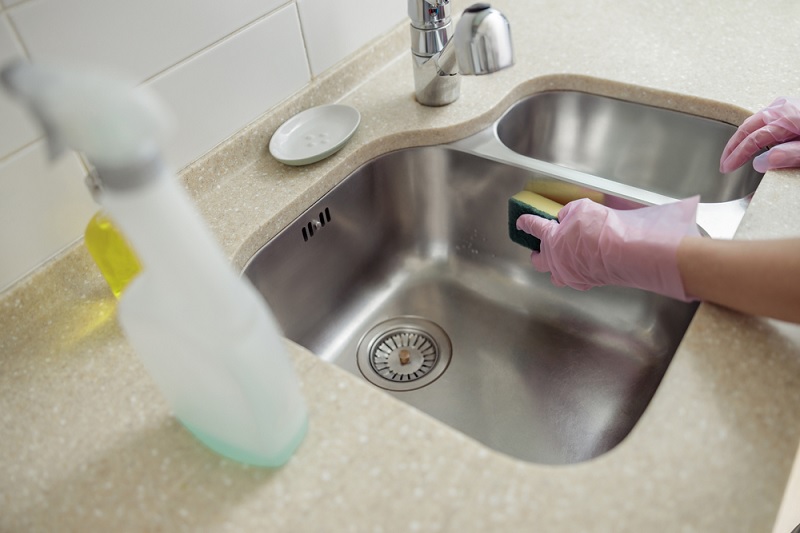Almost every home in the UK has some sort of stainless steel in it, whether it be a set of stainless-steel cutlery, a heated towel rail or a cooker hood! And each piece, whatever it may be, needs to be cleaned.
But how do you clean stainless steel? And what’s the simplest way of maintaining it?
Read on to learn more about washing and caring for stainless steel items in a home.
Below you’ll discover how to take care of your stainless-steel items daily. You’ll also find out how to perform a deep clean and polish on your items, as well as how to keep your pieces looking swell in between cleans.
Daily Cleaning
For your everyday cleaning, you generally won’t need to use specialised equipment and products! A little warm water, washing-up liquid and a lint-free cloth are what you’ll need!
Check out the options below:
Option 1: Hot cloth
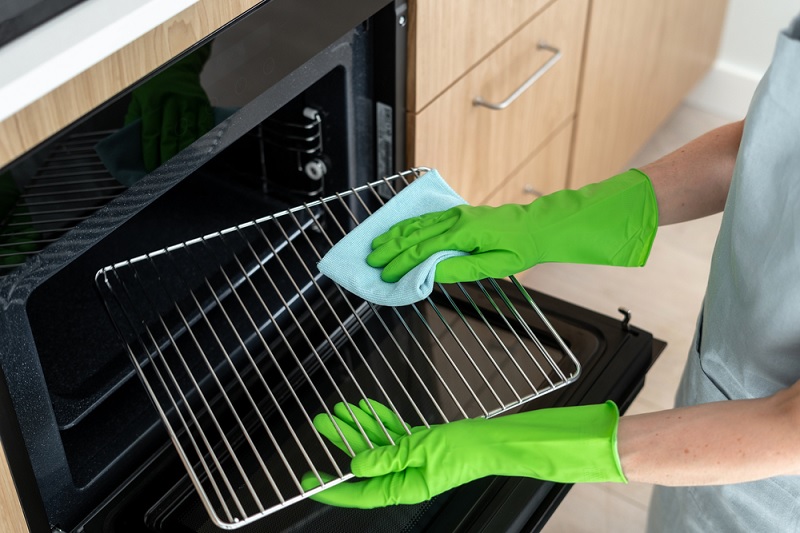
In most cases, you can clean stainless-steel surfaces and the outside of appliances with a hot, damp microfibre cloth.
Rub the stainless steel in a circular motion and with the grain to dislodge the dirt. When you’re done cleaning, you need to wipe the entire surface with a lint-free cloth, to prevent streaks and blemishes from appearing.
Tip: This method works particularly well when cleaning oversized, clumpy items (splashbacks and cooker hoods, for example) that cannot be washed through traditional means (in a sink).
Option 2: Soapy water
For stainless steel items coated in stubborn blemishes, you can clean the surfaces (oven, microwave and toaster, for example) in the same way as Option 1.
The only difference is that this time you’ll need to add a few drops of washing-up liquid to the cloth, so you can coat the steel surface in soap, which can break through the toughened grime.
Make sure that the appliance you’re cleaning is off when you carry out the cleaning activity. And don’t oversaturate the piece in water or get water onto any of the electronics!
To clean stainless steel items that’ll fit into a sink (cutlery, pans and serving dishes, for example), you’ll need to fill a sink with warm water and washing-up liquid and allow the stainless-steel pieces to soak in the water before rubbing them clean with a soft cloth.
Your knives, forks and saucepans must be cleaned in this manner because they’ll be covered in food residues, sauces and splashes! It would be unwise and unhygienic to leave such items in this manner.
When you’re done cleaning your stainless-steel surfaces, you’ll need to remove the suds/residue from the surface using a second damp, hot cloth. In the case of small items, like cutlery and pans, you can rinse them under the tap.
Remember to dry every piece you clean with a lint-free cloth when you’re done. If you skip this step and allow your pieces to air dry, they’ll end up with water marks on them!
Option 3: Dishwasher
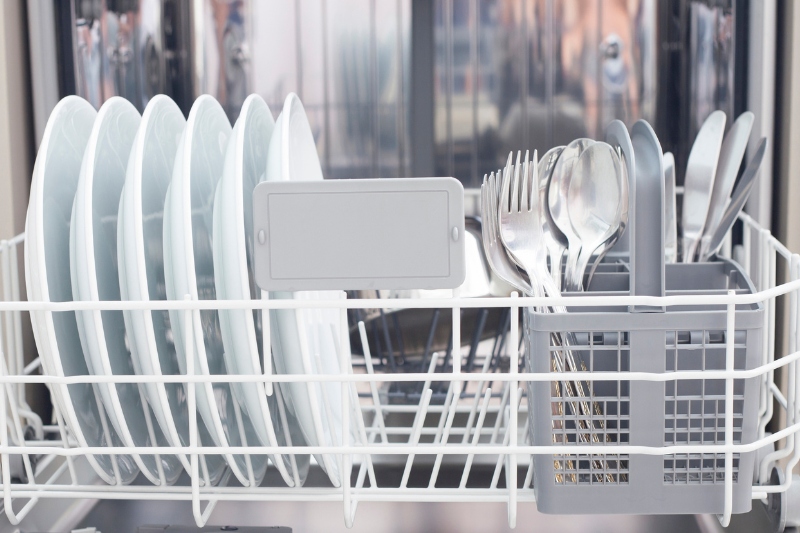
Many stainless-steel items in your home will be appliance-based or fixed in place, so they won’t be able to go inside a dishwasher.
However, there are several items that can be cleaned in a dishwasher. These include stainless-steel pots and pans, cutlery, utensils and dishes.
To clean said items in a dishwasher, you must first make sure they’re all dishwasher-friendly. Then you can clean the items quickly, as noted in Option 2 (above), before loading them into the dishwashing machine.
Remember to load your items into the machine carefully so that your pans and utensils don’t stick together (if this happens, the pieces won’t end up clean). Then add your cleaning solution, choose an appropriate washing cycle, and start the cycle!
When the cycle ends, you can inspect each item, dry them and store them accordingly. You must dry your stainless-steel items even if they feel touch dry because they can still be coated in water marks and heat streaks.
A quick dry with a lint-free cloth can remove these blemishes and bring a shine to your items.
Deep Cleaning and Removing Stains/Fingerprints
From time to time, you’ll have to invest a little more time in the stainless-steel cleaning process and do a deeper clean of your items.
As a rule, if you stay on top of your ‘everyday’ cleaning, your ‘deep clean’ shouldn’t be too much trouble!
But if you allow dust, food and gunk to build up on items, you’ll have to dedicate more time to the deep cleaning activity!
Try the options below:
Option 1: Steam cleaning
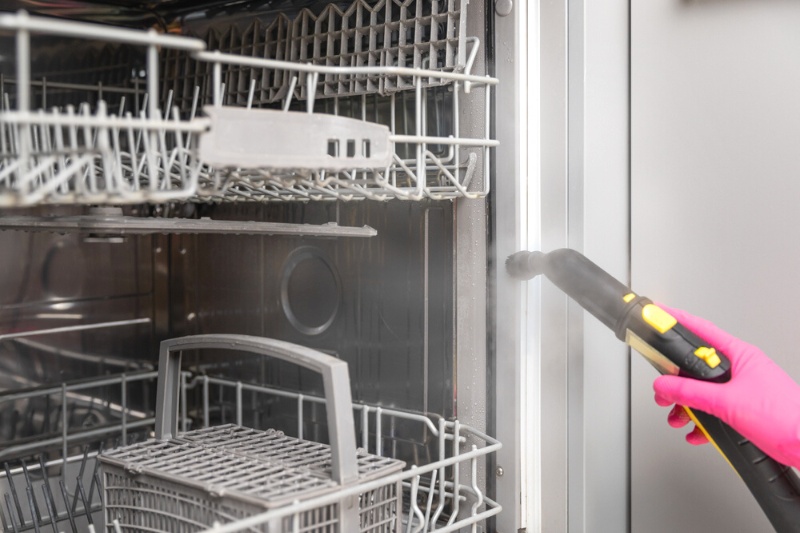
If you have some spare time and a steamer at home, you could try steaming your stainless steel clean.
For this to work out effectively, you’ll have to stick to using soft tools. Otherwise, you’ll scratch the surface!
This method works better on larger surfaces in general, so stick to trying it out on cooker hoods and splashbacks, for example.
Option 2: White vinegar
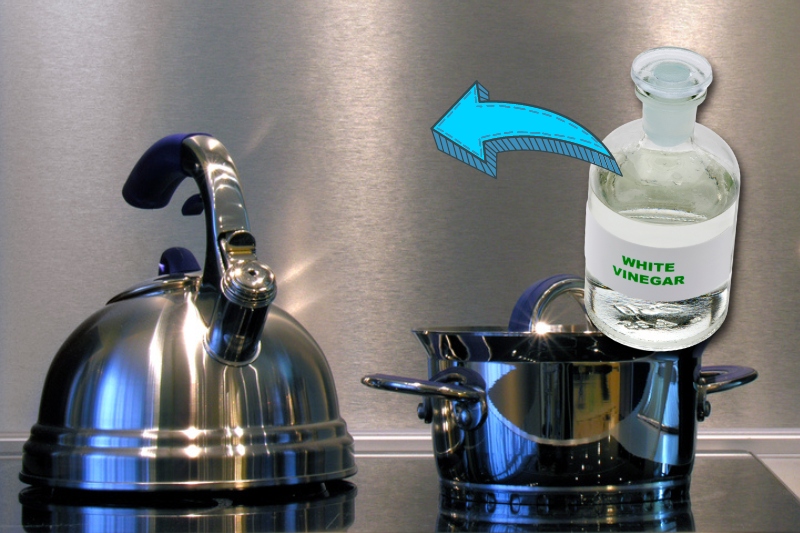
White vinegar can cut through grime and grease with ease, and it can also bring a shine back to surfaces.
To use it to clean stainless steel, fill a clean spray bottle with one part white vinegar to three parts warm water. Then spray the stainless-steel surface you want to clean with the solution and wipe it with a microfibre cloth.
Don’t allow the solution to rest on the surfaces for too long, so continuously rub the entire piece in a circular motion.
When you’re done, grab a second clean, damp cloth and rub it all over the surface to remove as much product residue as possible from it.
You can then dry the whole surface with a lint-free cloth and buff it to a shine in the process.
Option 3: Bicarbonate of soda
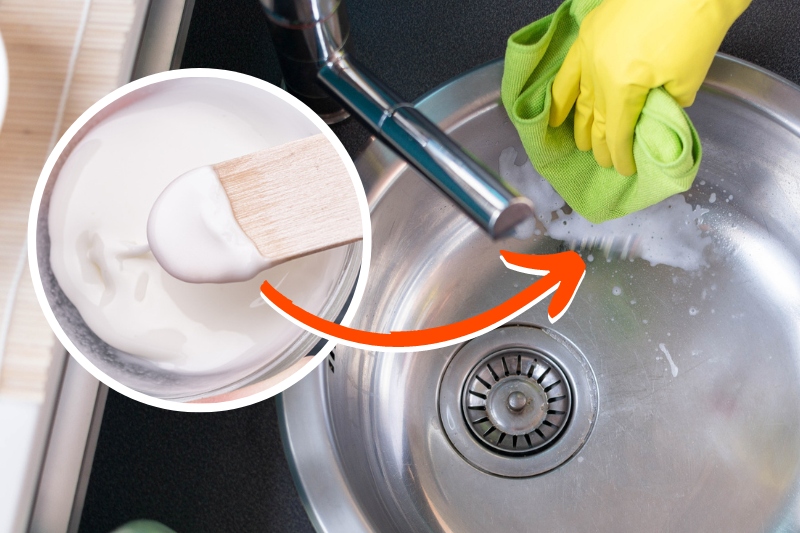
If you’ve got toughened stains on your stainless-steel items, coat them with a bit of bicarb!
In a shallow dish, make a paste from bicarbonate of soda and warm water. Ensure the paste has a good consistency (not too runny), and then spread it over the blemished areas.
Wait about half an hour before rinsing the areas clean using a damp, hot cloth.
You’ll have to make sure that all the paste has been removed from the surface before you can dry it!
You can apply the steps above to cutlery and other small stainless-steel items too.
Option 4: Stainless steel cleaner
There are countless stainless steel cleaners available to buy today. Here are some of the most popular ones:
- If you’re looking for an all-in-one type of stainless steel cleaner that can tackle burnt-on food, streaks, and fingerprints, look no further than HG Stainless Steel Cleaner. HG’s Stainless Steel Cleaner gets to work in mere minutes, and the so-easy-to-use solution will leave your kitchen surfaces glowing, protected and free from dirt.It’s also excellent at maintaining appliances that can’t be cleaned in a sink or dishwasher, like fridges, ovens and microwaves. Plus, it can be used on chrome surfaces!
- ProCook Stainless Steel Cleaner is a UK-made natural formula that can remove water marks, grease, general dirt and fingerprints from stainless steel surfaces. Like HG’s cleaner, ProCook’s solution is also straightforward to use – all you need to do is spray the solution onto the stainless-steel surface (like a sink), rub the surface with a microfibre cloth and buff the area to a shine.
- If you’re looking for a different kind of cleaner, perhaps Astonish’s Premium Edition Stainless Steel Cleaner & Sponge is what you’re after! Like the products listed above, the sponge can easily cut through toughened grime on cooker hoods, splashbacks and ovens. In turn, appliances are left protected from rust and with a sparkling appearance.
To make the most out of this product, you’ll have to use a little more elbow grease as there’s a lot of rubbing and buffing involved, but you do end up with great results!
Note: Choose a product that is suitable for the surface you’re attempting to clean. And make sure the cleaner can be used on the type of stainless steel you have (check to see if the solution will affect any coatings the steel has, for example).
Option 5: Glass cleaner
Got a load of fingerprints and streaks on your stainless-steel appliances? You’re not alone!
A quick and simple way to remedy this situation is to spray a little window cleaner (ammonia-free) onto the surface and then buff the surface to a shine using a microfibre cloth.
How to prevent stains from forming
Follow these tips to avoid getting stains on your stainless-steel surfaces:
- Clean your surfaces as soon as possible so gunk doesn’t have time to solidify and cause damage. This includes cutlery, sinks, pans and splashbacks, for example.
- Dry your items and surfaces after cleaning them so they don’t get caked in water marks, heat streaks and fingerprints.
- Make sure you rinse product residue off your stainless steel surfaces!
Restoring Shine to Stainless Steel
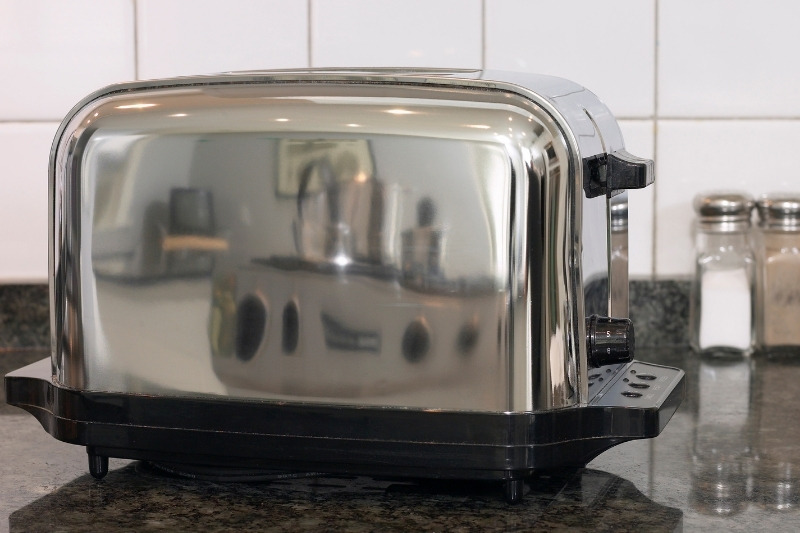
It’s not unheard of for stainless steel to dull with time. But you can cure this problem by polishing and protecting stainless steel. Try the options below.
Option 1: Buff with a cloth
A relatively straightforward and cheap way of bringing a shine back to stainless steel is to buff it with a lint-free cloth after it’s been cleaned. Just continuously rub an item in circular motions!
Buffing your item will give it a sparkle, and can remove pesky blemishes that are spoiling the appearance of the stainless steel.
Option 2: Stainless steel polish
As mentioned above, you can buy special polishes that are designed to bring a shine back to stainless steel surfaces (see suggestions above).
In most cases, polishes also add a protective coating to stainless steel pieces, so they’re protected from wear and tear for longer.
If you’re going to go down this route, make sure you choose a suitable polish for your stainless-steel surface, ideally one that won’t damage or weaken any coatings your stainless steel has on it.
Additionally, you should ensure that the polish can be used safely in a kitchen.
For example, you want to make sure that what you’re using to treat your surfaces isn’t going to harm you, a family member, or your food in any way.
You don’t want to coat your fridge in a chemical-laden product and then have your food rub up against it! This could be dangerous for you.
So, think about what product you’re buying and using.
Option 3: Oil
To bring a shine back to your stainless steel, you can coat the surface with some oil and buff it clean.
You can try olive oil or lemon oil. Just remember to buff the surface thoroughly so you remove oily residues from the item!
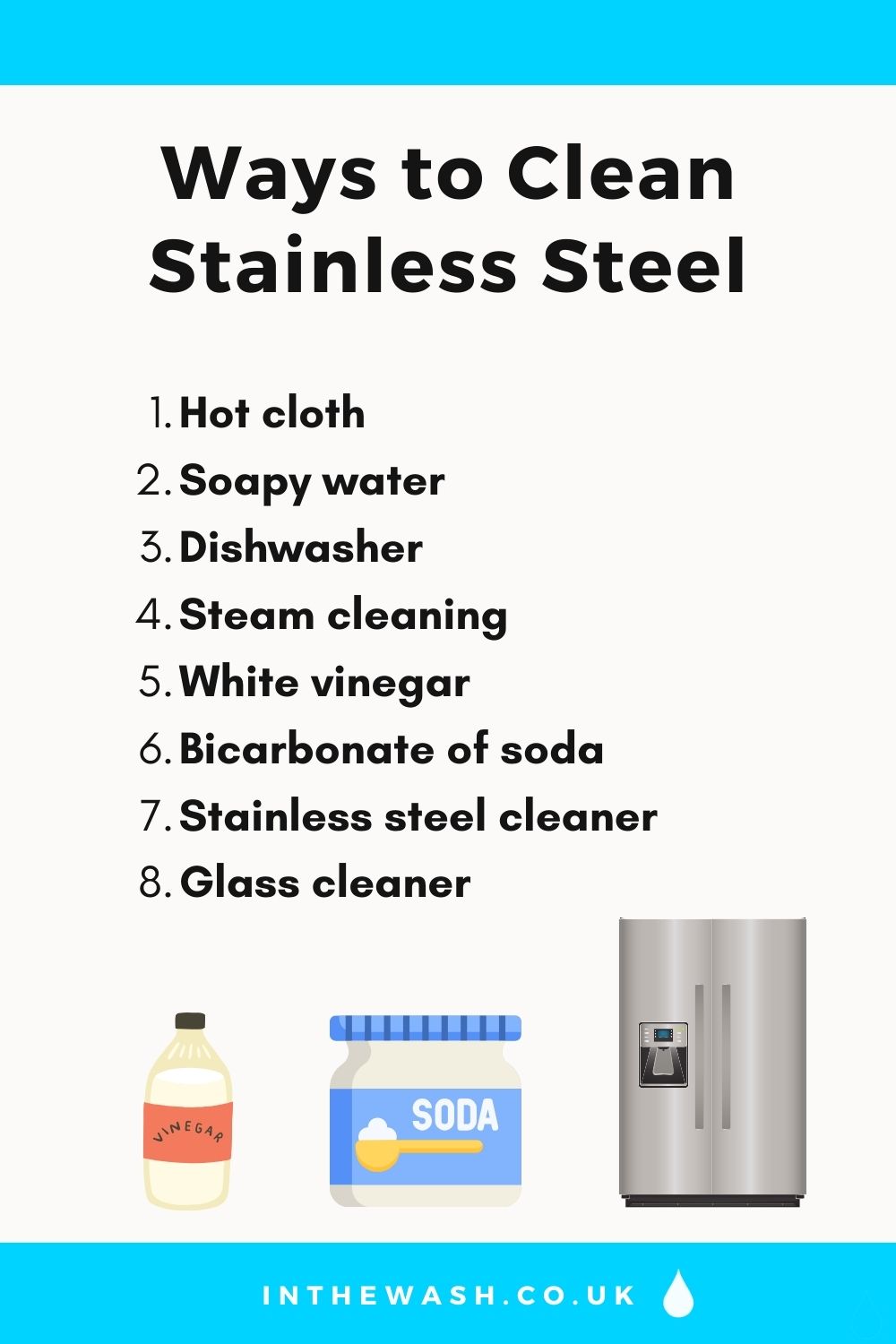
The Dos and Don’ts of Cleaning Stainless Steel
Do
- Wipe stainless steel with the grain and use circular motions.
- Read your user manual to find out how an item should be treated and cared for. Cleaning stainless steel items and appliances in the correct way can stop you from voiding your warranty. Plus, some stainless steels are coated with special protective layers, while others aren’t. And you wouldn’t want to strip this off your piece during the cleaning process.
- Consistently clean and buff your stainless-steel surfaces so dirt, fingerprints and water marks don’t build up on them.
- Always dry your stainless-steel surfaces after cleaning them. It’s worth drying your items with a lint-free cloth, like a microfibre one, so your items don’t get caked in fluffy fibres.
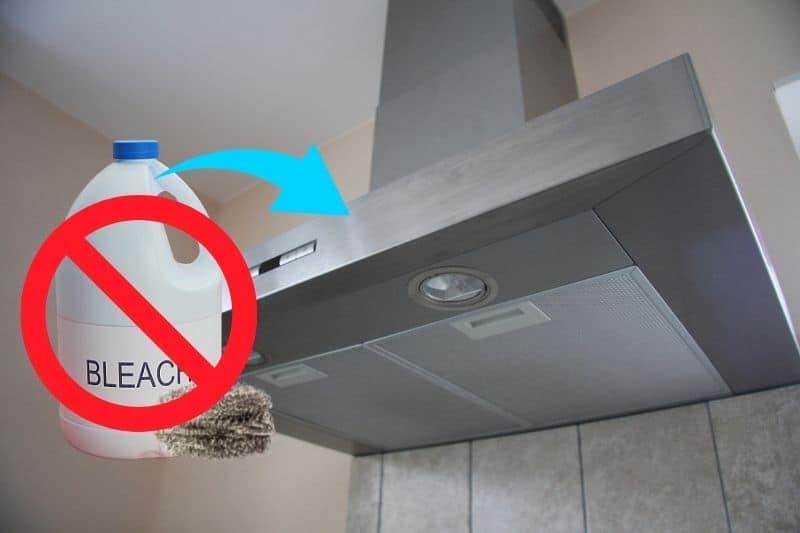
Don’t
- Don’t use bleach or bleach-based cleaning products to clean stainless steel.
- Don’t use harsh chemical-lined cleaning solutions.
- Don’t use harsh cleaning tools like hard-bristled brushes and scourers to clean stainless steel surfaces.
- Don’t leave grime on your stainless-steel surfaces. Not only does it look unsightly, but the items may start to tarnish.
- Don’t cover surfaces in pure vinegar. The vinegar must be diluted in water beforehand.
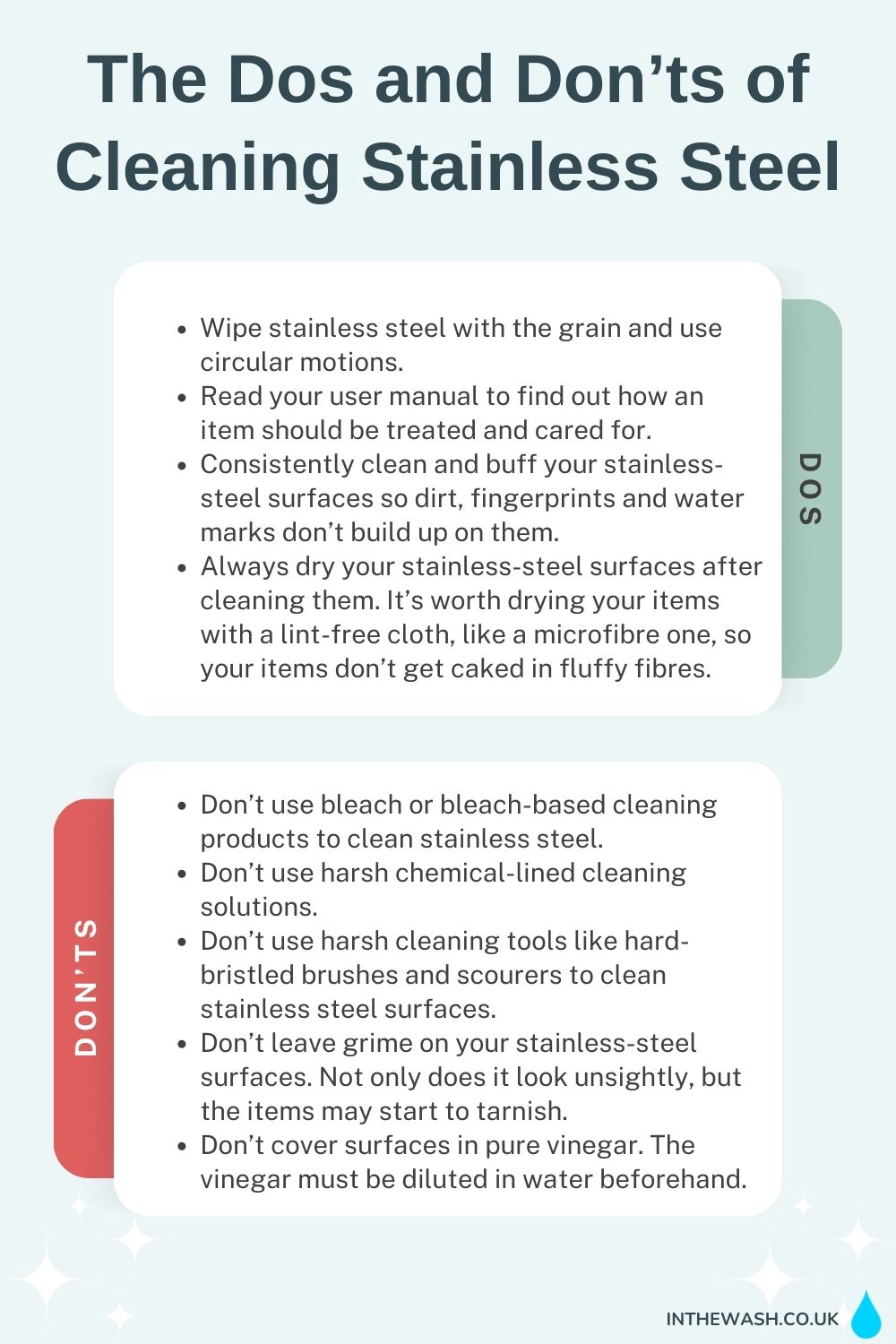

Bethan has a passion for exploring, reading, cooking and gardening! When she’s not creating culinary delights for her family, she’s concocting potions to keep her house clean!
